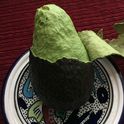Why did my refrigerated chocolate chip cookie dough turn dry, and not spread out in the oven?
The other day I made chocolate chip cookie dough using "The New York Times" recipe:
2 cups minus 2 tablespoons (8 1/2 ounces) cake flour
1 ⅔ cups (8 1/2 ounces) bread flour
1 ¼ teaspoons baking soda
1 ½ teaspoons baking powder
1 ½ teaspoons coarse salt
2 ½ sticks (1 1/4 cups) unsalted butter
1 ¼ cups (10 ounces) light brown sugar
1 cup plus 2 tablespoons (8 ounces) granulated sugar
2 large eggs
2 teaspoons natural vanilla extract
1 ¼ pounds bittersweet chocolate disks or fèves, at least 60 percent cacao content (see note)
Sea salt.
however, I replaced the butter with browned butter. I refrigerated the dough for over 48 hours in the original mixing bowl and loosely covered it in saran wrap. The dough became very dry and when baked it didn't spread. Where did I go wrong??
12 Comments
I use a small ice cream scoop to form the balls. Place them on s cookie sheet, freeze them until until solid (about 15 minutes)place in zip bag. When ready to bake, place frozen balls on ungreased pan, 375 degrees, 10 minutes exactly, they may not look done but they will when cool. Over baking will result in dried out cookies.


